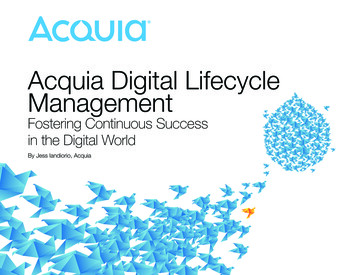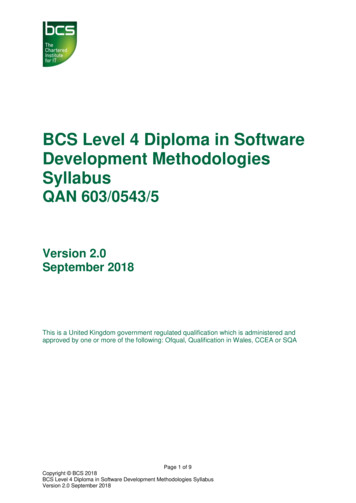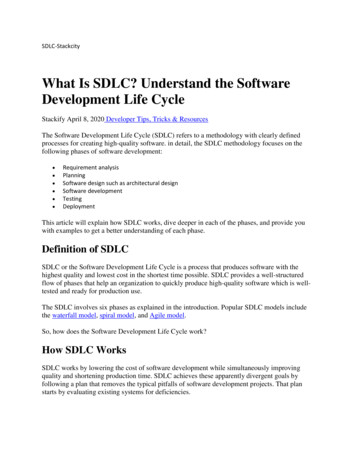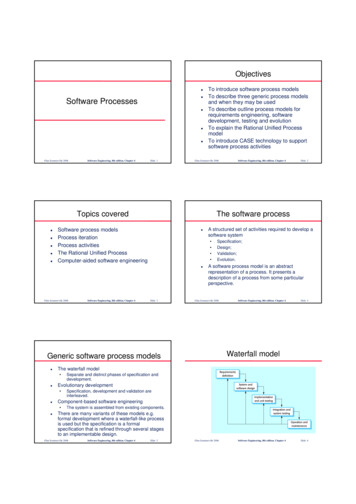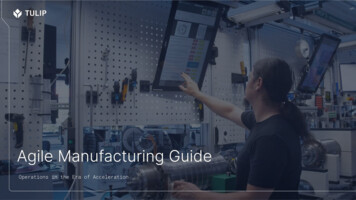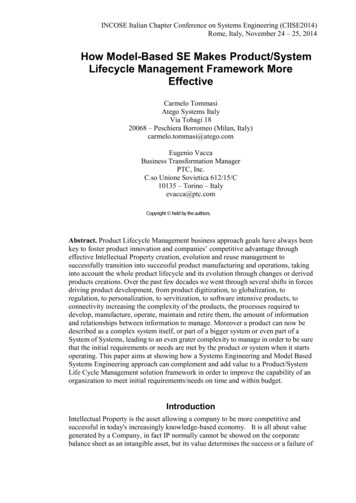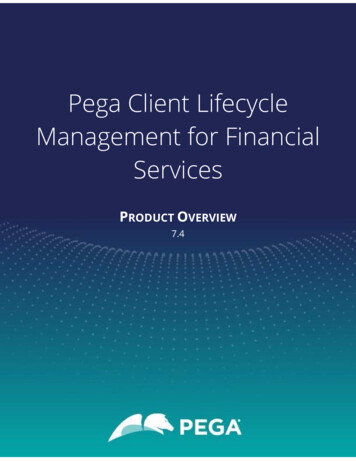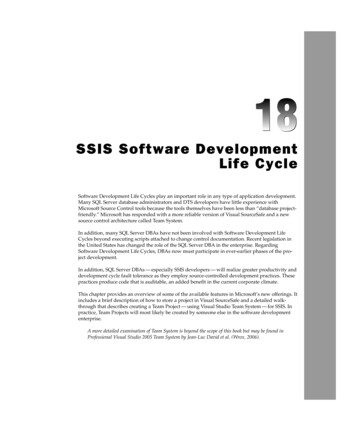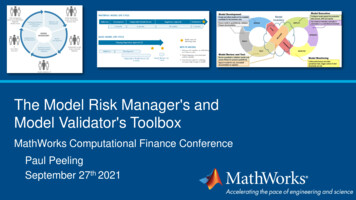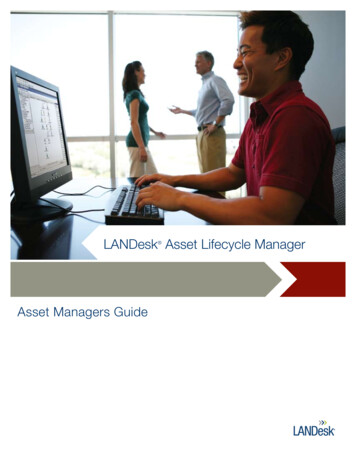
Transcription
Slide 6.1System development lifecycle – waterfall modelFigure 6.1The waterfall model of system development lifecycleCadle and Yeates, Project Management for Information Systems, 5th Edition, Pearson Education Limited 2008
Slide 6.2The ‘b’ modelFigure 6.2The ‘b’ modelSource: N D Birrell and M A Ould, A Practical Handbook for Software Development, Cambridge University Press, 1985Cadle and Yeates, Project Management for Information Systems, 5th Edition, Pearson Education Limited 2008
Slide 6.3The ‘V’ modelFigure 6.3The ‘V’ modelSource: Reproduced with permission of the National Computing Centre Limited from the STARTS Guide, 1987, which was supported by the Department of Trade and IndustryCadle and Yeates, Project Management for Information Systems, 5th Edition, Pearson Education Limited 2008
Slide 6.4The incremental approachFigure 6.4The incremental modelCadle and Yeates, Project Management for Information Systems, 5th Edition, Pearson Education Limited 2008
Slide 6.5The spiral model – evolutionary developmentFigure 6.5Boehm’s spiral modelSource: 1988 IEEECadle and Yeates, Project Management for Information Systems, 5th Edition, Pearson Education Limited 2008
Slide 6.6Structured systems developmentProvide dataand nsesDerive logicaldescriptionAgreed onsAgreedphysicaldescriptionAssist/agreein preparinglogical agreein producinglogical viewSuggesteddesignProducelogical designAgreed logicaldesignProducephysicaldesignDevelopersDraft signTo programmespecification,coding etc.Greater user involvement at all stages; driven by usersCadle and Yeates, Project Management for Information Systems, 5th Edition, Pearson Education Limited 2008
Slide 6.7Agile approaches – origins Addresses long-windedness of other approaches Prototyping used to:– assist users define requirements by demonstratingpossibilities– investigate novel methods of working– test performance implications– assist in considering work practicesCadle and Yeates, Project Management for Information Systems, 5th Edition, Pearson Education Limited 2008
Slide 6.8Agile approaches – features Success dependent on empowerment of users anddevelopers Deliverables reviewed for business fitness Testing integral to iterative lifecycle All changes reversible Incremental/partial delivery acceptable ‘Timeboxing’ used to control timescale (and budget) Workshops widely usedCadle and Yeates, Project Management for Information Systems, 5th Edition, Pearson Education Limited 2008
Slide 6.9Agile methods 1 – Scrum Scrum. Origins in USA. Scrum is daily meeting to review progress and resetpriorities. Development done in 30-day ‘Sprints’. Every aspect of the project time-boxed. Project manager is ‘ScrumMaster’ – different fromthe usual PM role – teams self-governing.Cadle and Yeates, Project Management for Information Systems, 5th Edition, Pearson Education Limited 2008
Slide 6.10Agile methods 2 - DSDM Eight principles:12345678Focus on business need.Deliver on time.Collaborate.Never compromise quality.Develop solution iteratively.Build incrementally from firm foundations.Communicate continuously and clearly.Demonstrate control.Cadle and Yeates, Project Management for Information Systems, 5th Edition, Pearson Education Limited 2008
Slide 6.11Object-oriented development Object is a package of software containing:– ‘variables’ (data).– ‘methods’ (processes) Objects communicate via messages. System is built up from intercommunicating objects. Deals with problem of integration of large systems.Cadle and Yeates, Project Management for Information Systems, 5th Edition, Pearson Education Limited 2008
Slide 6.12UML and Unified Process Unified Modeling Language provides visual languagefor OO projects. Unified Process provides process model. Approach ‘open’ (non-proprietary) but RationalCorporation offers Rational Unified Process. Four phases to onTransition.Cadle and Yeates, Project Management for Information Systems, 5th Edition, Pearson Education Limited 2008
Slide 6.13Component-based development Development of reusable components Aim – to create libraries of components that can becombined to build new systems Long-term benefits – reduce development costs andproduce more reliable systems Short-term costs often higher – because of need toconsider wider usage of componentsCadle and Yeates, Project Management for Information Systems, 5th Edition, Pearson Education Limited 2008
Slide 6.14Extreme programming Created to deal with rapidly changing requirementsWorks best on relatively small projectsOr on enhancements to existing systemsDevelopers work in pairsTesting – integral part of processEmphasis on frequent releases of small-scalepackages of softwareCadle and Yeates, Project Management for Information Systems, 5th Edition, Pearson Education Limited 2008
Slide 6.15Package-based IS projects Quicker and cheaper to buy commercial off-the-shelf(COTS) solution than build from scratch. Two main types of project:– Package-constrained – users adapt to what packagecan do.– Package-based – package tailored to users’ exactneeds. Extensive tailoring probably more expensive thanbespoke development.Cadle and Yeates, Project Management for Information Systems, 5th Edition, Pearson Education Limited 2008
Slide 6.16Soft systems and the Socio-TechnicalApproach Not really an IT development method But does consider a wider ‘human activitysystem’ (business system) of which IT is a part Recognizes that real-world problems rarely blackand whiteCadle and Yeates, Project Management for Information Systems, 5th Edition, Pearson Education Limited 2008
Slide 6.17Business process re-engineering Originated by US consultants Michael Hammer andJames Champy. Involves going back to first principles and redesigning optimal business systems. Leads to radical changes to organizations andfundamental changes to processes. High reward – but high risk also.Cadle and Yeates, Project Management for Information Systems, 5th Edition, Pearson Education Limited 2008
Slide 6.18Functional organizationFigure 4.1Functional organization structureCadle and Yeates, Project Management for Information Systems, 5th Edition, Pearson Education Limited 2008
Slide 6.19‘Pure’ project structureFigure 4.2‘Pure’ project structureCadle and Yeates, Project Management for Information Systems, 5th Edition, Pearson Education Limited 2008
Slide 6.20Matrix structureFigure 4.3Matrix structureCadle and Yeates, Project Management for Information Systems, 5th Edition, Pearson Education Limited 2008
Slide 6.21Generic project organizationFigure 4.4Generic project organization and rolesCadle and Yeates, Project Management for Information Systems, 5th Edition, Pearson Education Limited 2008
Slide 6.22Programme and portfolio managementFigure 4.5Programme and portfolio managementCadle and Yeates, Project Management for Information Systems, 5th Edition, Pearson Education Limited 2008
Slide 6.23PRINCE2 organization structureFigure 4.6PRINCE2 organization structureCadle and Yeates, Project Management for Information Systems, 5th Edition, Pearson Education Limited 2008
Slide 6.24Scheduling effort and elapsed time Effort total volume of work. Elapsed time depends on effort and also:– How many resources are available.– What proportion of their time is available to the project.– Delays outside the team’s control (eg lead times forhardware).– Dependencies on others.Cadle and Yeates, Project Management for Information Systems, 5th Edition, Pearson Education Limited 2008
Slide 6.25Network diagramFigure 10.1Dependency network with activity durationsCadle and Yeates, Project Management for Information Systems, 5th Edition, Pearson Education Limited 2008
Slide 6.26Bar chartFigure 10.3Schedule for two-person team showing parallel activitiesCadle and Yeates, Project Management for Information Systems, 5th Edition, Pearson Education Limited 2008
Slide 6.27Bar chart with milestones addedFigure 10.6Bar chart showing project milestonesCadle and Yeates, Project Management for Information Systems, 5th Edition, Pearson Education Limited 2008
Slide 6.28Bar chart with ‘overhead’ task addedFigure 10.7Bar chart showing project management as continuous activity overprojectCadle and Yeates, Project Management for Information Systems, 5th Edition, Pearson Education Limited 2008
Slide 6.29Bar chart and resource histogramFigure 10.8Bar chart with resource histogramCadle and Yeates, Project Management for Information Systems, 5th Edition, Pearson Education Limited 2008
Slide 6.30The project and other plansOne document orPROJECT PLANtwo?Why? What? When?Where? Who?QUALITY PLANQUALITY PLANHow?HowRISK MANAGEMENTPLANWhy not?One plan orthree?Cadle and Yeates, Project Management for Information Systems, 5th Edition, Pearson Education Limited 2008
Slide 6.31PRINCE2 plansFigure 10.10PRINCE2 plansCadle and Yeates, Project Management for Information Systems, 5th Edition, Pearson Education Limited 2008
Slide 6.32Contents of PRINCE2 project/stage planFigure 10.11Contents of PRINCE2 project and stage plansCadle and Yeates, Project Management for Information Systems, 5th Edition, Pearson Education Limited 2008
Slide 6.33Project budgetFigure 10.13Example budget for an IT projectCadle and Yeates, Project Management for Information Systems, 5th Edition, Pearson Education Limited 2008
UML and Unified Process Unified Modeling Language provides visual language for OO projects. Unified Process provides process model. Approach 'open' (non-proprietary) but Rational Corporation offers Rational Unified Process. Four phases to process: - Inception - Elaboration - Construction
